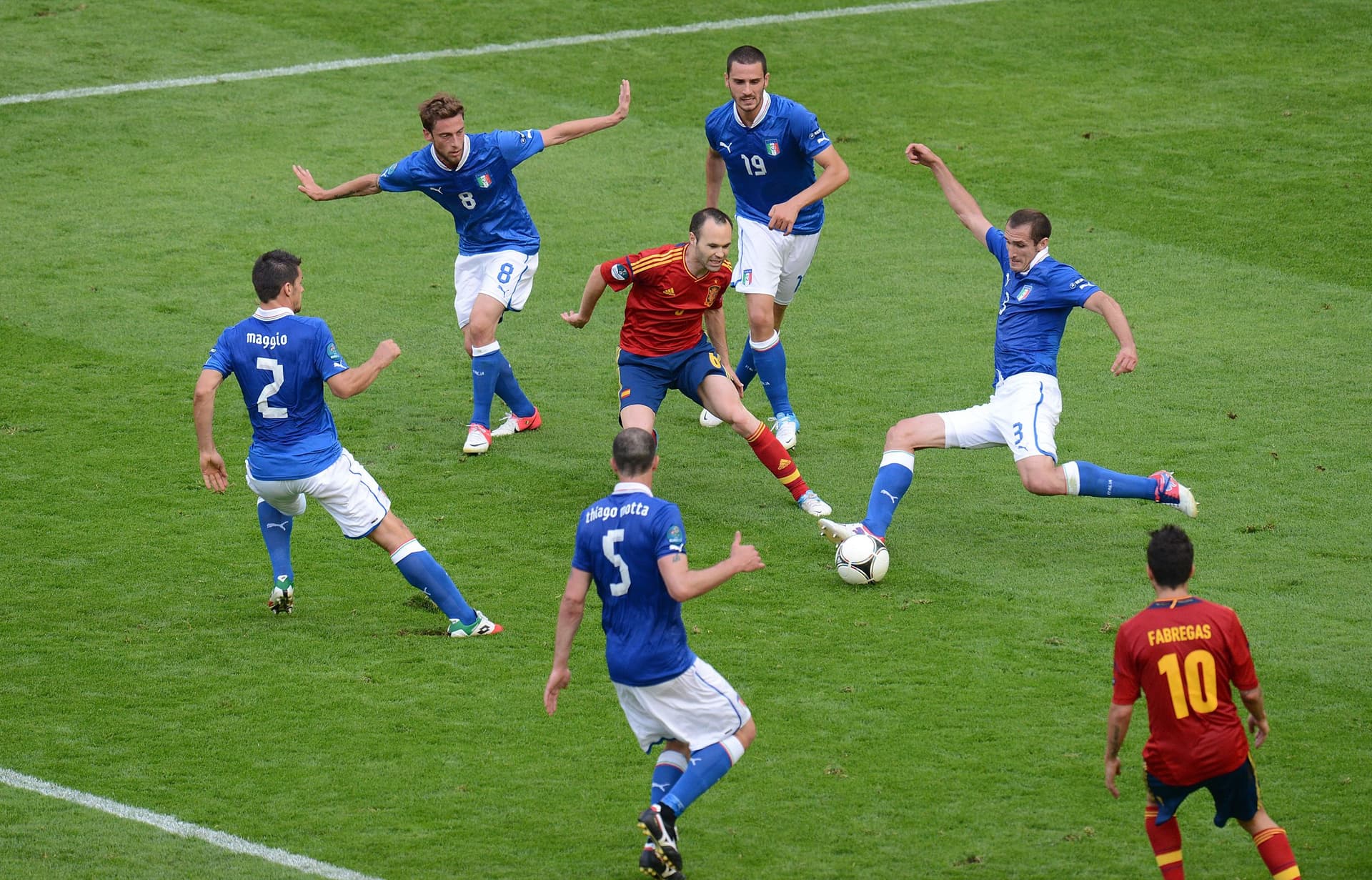Football
Positions on a Football Team
Association Football has eleven players, ten outfield players and the goalkeeper. These are three sets of collective positions in the outfield: defenders, midfielders, and forwards. These are the 11 positions in football.

Football International European Championship 2012//Getty Images
There are eleven players in the starting lineup of an Association Football team. The reserves vary from amateur to professional, but five substitutes can be used in most professional leagues worldwide, including international-level football. There are four sets of positions: the goalkeeper, defenders, midfielders, and forwards.
These four sets of positions can be broken into subsets depending on the formation a manager sets his team up to play. SportsBoom gives a comprehensive run-down of the positions on a football team and explains the different roles each position is responsible for during a match. The numbers of the positions vary because of increased squads and players choosing their numbers rather than being that position on the field.
What are the Names of the Positions on a Football Team?
The starting XI on a football team comprises one goalkeeper, three to five defenders, two to five midfielders, and one to four forwards. The number of players in each set of positions depends on the team’s tactics and formation. A standard 4-4-2 formation comprises four defenders, four midfielders, and two forwards. Two of the four defenders are on either side of the two central defenders are called centre-halves.
The wide defenders are known as fullbacks; one right, the other left. The midfield is similar in set up. There are two wide midfielders and two central midfielders. The wide midfielders are called left wings, or right wingers. The two central midfielders are made up of one defensive, and one attacking midfielder. The two forwards are called strikers or target men.
If a team plays in a 4-3-3 formation, the four defenders are the same as 4-4-2, but three midfielders have unique roles. One midfielder is the holding midfielder, who plays in front of the back four, and behind the two attacking midfielders. The forwards are comprised of two goalscoring wingers and a central striker. The right and left wingers are interchangeable.
Overview of Positions in Modern Association Football
| Positions | Shirt Numbers |
| Goalkeeper | 1 |
| Defenders | 2,3,4,5,6 |
| Midfielders | 3,4,5,6,7,8 |
| Forwards | 7,8,9,10,11 |
In a 4-2-3-1 formation, two defensive (holding) midfielders sit in front of the back four. Two wingers are positioned on either side of the No. 10, who is the playmaker in the ‘hole’ behind the lone striker. A 3-5-2 formation has three central defenders instead of two. Two wingbacks play on the flanks.
The role of the wingbacks is to provide attacking width, but also to defend like traditional fullbacks. The midfield is made up of two or three midfielders depending on if the coach wants to play defensively or play with a more attack-minded philosophy. However, this formation is usually played by weaker teams trying to beat a better opponent. The two strikers play up front.
Football Positions: Goalkeeper
The goalkeeper is the only player allowed to use his hands (within the 18-yard area). Goalkeeping is – probably – the hardest position to play in football. It is a lonely job, and any error is highlighted more critically than mistakes from the outfield players often prove costly.
Football Positions: Defenders
The are four types of defenders: fullbacks, centre halves, wingbacks, and a sweeper. The sweeper position has, however, gone out of fashion since the 1980s. It is rarely used in professional football because of the modern deep-lying midfielder position or holding midfielder. A deep-lying midfielder, also called a number six, is a combination of the sweeper and defensive midfielder role.
Breakdown of Numbers & Positions in Association Football
| Shirt Numbers | Names of Positions |
| 1 | Goalkeeper |
| 2 | Right Full Back / Wing Back |
| 3 | Left Full Back / Wing Back / Midfielder |
| 4 | Right-Sided Centre Half / Centre Back |
| 5 | Left-Sided Centre Half / Centre Back / Sweeper |
| 6 | Holding Midfielder / Centre Midfield |
| 7 | Right-Sided Midfielder / Winger |
| 8 | Centre Midfield |
| 9 | Centre Forward / Striker |
| 10 | Attacking Midfielder / Second Striker / Centre forward |
| 11 | Left-Sided Midfielder / Left Wing |
Roles of the Midfielders
Midfielders patrol the centre part of the field. They provide cover for the defence, and support to the attackers. In modern football, managers deploy two defensive midfielders and a playmaker, or one holding midfielder and two attacking playmakers in a 4-3-3 formation. Wings must help cover the two fullbacks when defending.
For a 4-4-2 formation, the midfield comprises of one holding, and one attacking midfielder. Wingers patrol the touchline in a 4-4-2. Their roles are to provide width, and cross balls into the box for the two strikers. Every team, no matter the formation, must have a balance of defence and attack.
There are never three attacking midfielders and no defensive players. However, defensive-minded managers sometimes deploy three defensive midfielders. The best midfielders are versatile, and can play many positions, including as a second striker.
Roles of the Forwards
Forwards provide most of the attacking intent. The forwards comprise of left wingers, right wingers, playmakers, and strikers. Wingers in a 4-4-2 are a hybrid of defence and attack, but in a 4-3-3 formation, the wingers are forwards. Their primary role is to support the lone striker and provide goals. The two forwards in a 4-4-2 are called the striker and second striker. The second striker acts as a number ten or playmaker, connecting the forwards with the midfielders.
In a 4-2-3-1 formation, there are four forwards in front of the two holding midfielders: two wingers, one number ten, and a striker in front of the playmaker in the hole. The ‘hole’ is a roaming attacking position, with some defensive duties. The number ten must set the wingers away and provide through-balls for the striker. This position requires the player to contribute with goals and assists.
Roles of the Strikers
Strikers are forwards; however, their roles differ depending on formations. Many teams play with one striker in a 4-3-3 or 4-2-3-1 formation. In a 3-5-2, 4-4-1-1 or 4-4-2 formation, there are two strikers. In a 4-4-1-1, one striker plays behind his attacking partner. This role is for supporting the midfield and the top striker. It is like the number ten role in a 4-2-3-1 formation; however, the second striker plays deeper than the traditional number ten.

Kaylan Geekie is a sports fanatic. He attended Durban High School before moving to Scotland, where he lived for 15 years. During his time in the United Kingdom, Kaylan graduated with a first-class BA Honours Degree in Sports Journalism at the University of the West of Scotland. Kaylan worked for nine years as the Match-Day Editor of SuperXV.com, reporting on Super Rugby, The Rugby Championship, the 2015 Men's Rugby World Cup and the 2017 British & Irish Lions series for the website.